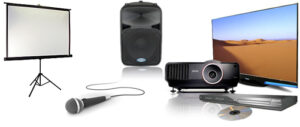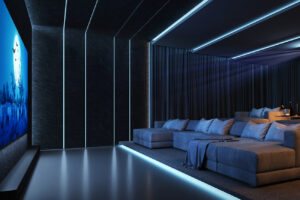Introduction
A home theater is a dedicated space within a residence designed to replicate the immersive experience of a commercial movie theater. It typically consists of a combination of audiovisual equipment, seating arrangements, and room design elements optimized for cinematic viewing and sound reproduction. Here’s an overview of the key components and considerations of a home theater.
1. Audiovisual Equipment: The cornerstone of any home theater is the audiovisual equipment, including a large-screen display or projector and a high-quality sound system. This may include a flat-screen television, a projection screen, or even a dedicated home theater projector for a truly cinematic experience. For audio, a surround sound system with multiple speakers strategically placed around the room delivers immersive sound, with options for Dolby Atmo’s or DTS: X for three-dimensional audio.
equipment, including a large-screen display or projector and a high-quality sound system. This may include a flat-screen television, a projection screen, or even a dedicated home theater projector for a truly cinematic experience. For audio, a surround sound system with multiple speakers strategically placed around the room delivers immersive sound, with options for Dolby Atmo’s or DTS: X for three-dimensional audio.
2. Seating Arrangements: Comfortable seating is essential for enjoying long movie nights or gaming sessions in the home theater. Home theater seating typically includes plush, reclining chairs or sofas with cup holders and built-in storage for snacks and remote controls. Some setups may feature tiered seating, similar to a commercial theater, to ensure optimal viewing angles for all viewers.
nights or gaming sessions in the home theater. Home theater seating typically includes plush, reclining chairs or sofas with cup holders and built-in storage for snacks and remote controls. Some setups may feature tiered seating, similar to a commercial theater, to ensure optimal viewing angles for all viewers.
3. Room Design and Acoustics: The design of the home theater room plays a crucial role in optimizing audio and video performance. Considerations include room dimensions, wall treatments for sound absorption and diffusion, carpeting or rugs to minimize sound reflections, and blackout curtains or shades to control ambient light for optimal viewing conditions. Proper room calibration and acoustical treatments help to create an immersive audiovisual environment.
4. Media Sources and Control Systems: Home theaters are typically equipped with various media sources, such as Blu-ray players, streaming devices, gaming consoles, and cable or satellite boxes, to access a wide range of content. A centralized control system, such as a universal remote or home automation system, simplifies operation by allowing users to control all audiovisual components from a single interface.
various media sources, such as Blu-ray players, streaming devices, gaming consoles, and cable or satellite boxes, to access a wide range of content. A centralized control system, such as a universal remote or home automation system, simplifies operation by allowing users to control all audiovisual components from a single interface.
5. Ambient Lighting and Décor: Ambient lighting and décor contribute to the overall atmosphere of the home theater, enhancing the viewing experience and adding to the aesthetic appeal of the space. This may include dimmable recessed lighting, LED accent lighting behind the screen or along the walls, and themed décor elements such as movie posters, popcorn machines, or vintage signage.
décor contribute to the overall atmosphere of the home theater, enhancing the viewing experience and adding to the aesthetic appeal of the space. This may include dimmable recessed lighting, LED accent lighting behind the screen or along the walls, and themed décor elements such as movie posters, popcorn machines, or vintage signage.
6. Content and Entertainment Options: With access to a plethora of content options, including streaming services, Blu-ray discs, digital downloads, and gaming platforms, home theaters offer endless entertainment possibilities for movie buffs, sports fans, gamers, and audiophiles alike. Customizable settings and presets allow users to tailor the viewing experience to their preferences.
including streaming services, Blu-ray discs, digital downloads, and gaming platforms, home theaters offer endless entertainment possibilities for movie buffs, sports fans, gamers, and audiophiles alike. Customizable settings and presets allow users to tailor the viewing experience to their preferences.
Conclusion
A home theater represents the epitome of personalized entertainment and luxury within one’s living space. It is a carefully crafted environment that transcends the typical living room setup to offer an immersive cinematic experience akin to commercial movie theaters. The integration of state-of-the-art audiovisual equipment, meticulously designed acoustics, comfortable seating arrangements, and ambient lighting, home theaters transform the act of watching movies, gaming, or streaming content into an unforgettable journey. The allure of a home theater lies in its ability to transport viewers into the heart of the action, enveloping them in stunning visuals, lifelike soundscapes, and unparalleled comfort. Whether it’s the crisp clarity of high-definition displays, the thunderous impact of surround sound systems, or the cozy embrace of custom seating, every element is meticulously calibrated to create an immersive viewing experience.

